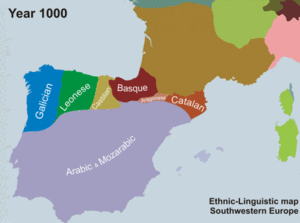Iberian Romance languages facts for kids
Quick facts for kids Iberian Romance |
|
|---|---|
| Ibero-Romance, Iberian | |
| Geographic distribution: |
Originally Iberian Peninsula and French Catalonia; now worldwide |
| Linguistic classification: | Indo-European
|
| Subdivisions: |
Mozarabic
|
The Iberian Romance languages are a group of Romance languages. They grew from Latin on the Iberian Peninsula. This area mainly includes Spain, Portugal, Gibraltar, Andorra, and French Catalonia.
Today, these languages are often split into three main groups:
- West Iberian (like Spanish and Portuguese)
- East Iberian (Catalan/Valencian)
- Mozarabic (an older, now extinct language)
Some experts debate where East Iberian languages truly belong. Some think they are closer to Gallo-Romance languages, which include French and Occitan.
The most common Iberian Romance languages are Spanish and Portuguese. After them come Catalan-Valencian-Balear and Galician. Each of these languages also has its own local ways of speaking. There are also some Portuguese-based creole languages and Spanish-based creole languages, like Papiamento.
Contents
How Iberian Romance Languages Started
Like all Romance languages, Iberian Romance languages come from Vulgar Latin. This was the everyday Latin spoken by soldiers and traders across the Roman Empire. It was different from the formal Latin used in books.
When the Roman Empire grew, people in new lands started speaking Vulgar Latin. Latin and its newer forms have been spoken in Iberia since the Punic Wars. This was when the Romans took over the area.
The modern Iberian Romance languages formed over a long time:
- First, the local people in Iberia started to speak Latin. This is called Romanization.
- Then, the Latin spoken in Iberia began to change. There were small differences from one place to another.
- Over time, these differences grew. This led to several distinct dialects of Ibero-Romance.
Between the 700s and 900s, languages like Old Spanish, Galician-Portuguese, Old Leonese, and Navarro-Aragonese developed from Latin. Early Catalan language also formed around this time.
There's still some discussion about how Navarro-Aragonese, Catalan, and Occitan are related. Some experts put them in the Iberian Romance group (calling them East Iberian). Others say they are part of the Gallo-Romance languages.
From the 1400s to the 1900s, these languages kept changing. They became the modern Spanish, Portuguese, Aragonese, Asturleonese, Galician, and Catalan we know today. You can find out more about them in articles about the languages of Iberia.
Main Iberian Romance Languages Today
There are four main Iberian Romance languages that are officially recognized. This means they are used by governments and in schools.
Spanish Language
Spanish is the official language in 21 countries, including Spain. It is one of the most spoken languages in the world. Over 570 million people speak Spanish in total. It is the second most spoken native language. Spanish has many different dialects and varieties.
Portuguese Language
Portuguese is an official language in nine countries. These include Portugal and Brazil. It is the second most spoken Romance language worldwide. Over 250 million people speak Portuguese. It ranks seventh by the number of native speakers. There are different Portuguese dialects outside of the standard European Portuguese.
Catalan Language
Catalan is the official language in Andorra. It is also co-official in parts of Spain, like Catalonia and the Balearic Islands. In the Valencian Community, it is known as Valencian. Catalan is also spoken in Northern Catalonia in France, but it is not official there.
Catalan is very similar to Occitan. Some linguists even treat them as one language. When they are not seen as one, they are often grouped as Occitano-Romance languages. This group is sometimes put with the Gallo-Romance languages. About 10 million people speak Catalan. It has two main dialect groups and several sub-dialects.
Galician Language
Galician is co-official in Galicia, Spain. It is also spoken in nearby parts of Asturias and Castile and León. Galician is very close to Portuguese. Both languages came from the medieval Galician-Portuguese. About 3.2 million people speak modern Galician.
Other Important Languages
Asturian is a dialect of Asturleonese. It is not an official language, but it is recognized in Asturias, Spain. Another Asturleonese dialect is Mirandese. Mirandese has official status as a minority language in Portugal.
Family Tree Overview
The Iberian Romance languages are a group of Romance languages. Many experts use this term to describe languages from the Iberian Peninsula. However, they might not all come from one single common ancestor.
Here is a simplified look at the main groups:
- Iberian Romance languages
- East Iberian (sometimes grouped with Gallo-Romance languages)
- West Iberian
- Asturleonese
- Castilian
- Galician-Portuguese
- Pyrenean–Mozarabic
- Aragonese
- Mozarabic† (extinct)
See also
 In Spanish: Lenguas iberorromances para niños
In Spanish: Lenguas iberorromances para niños
- Languages of Iberia
- Barranquenho



